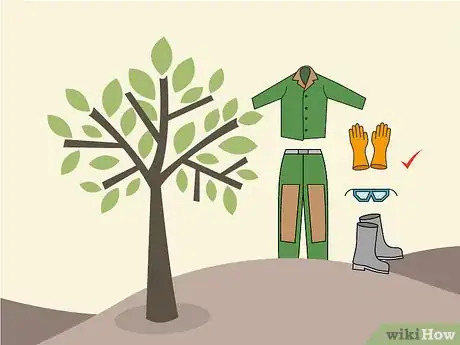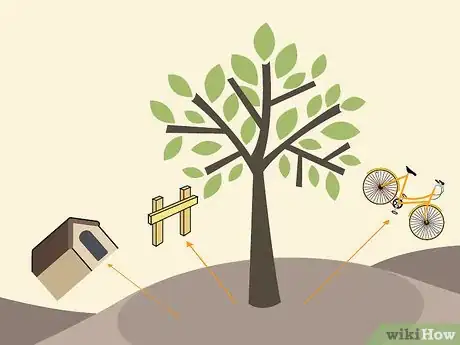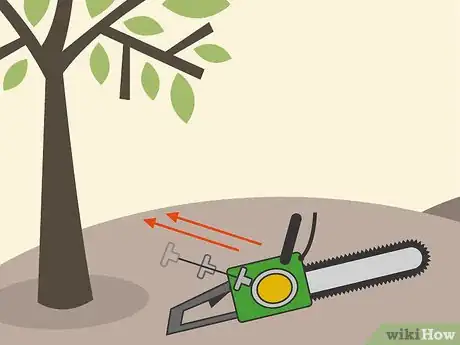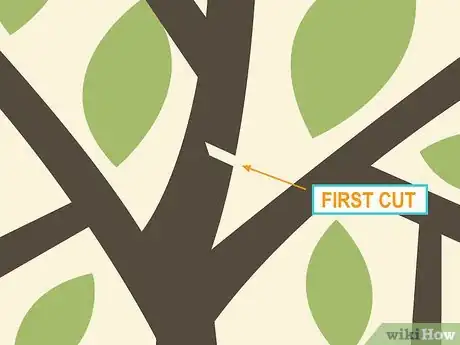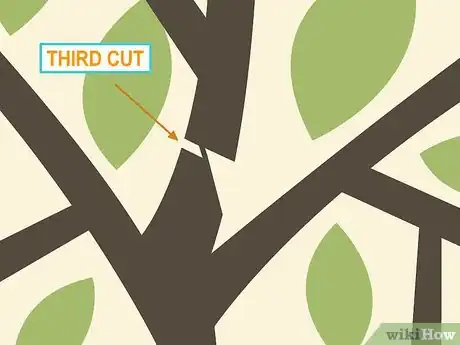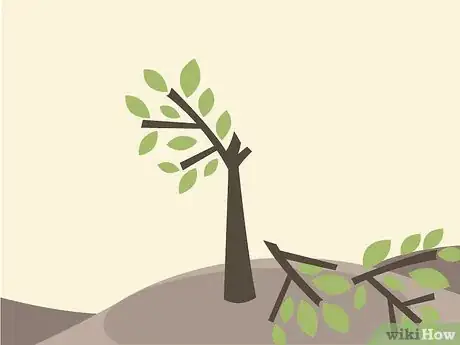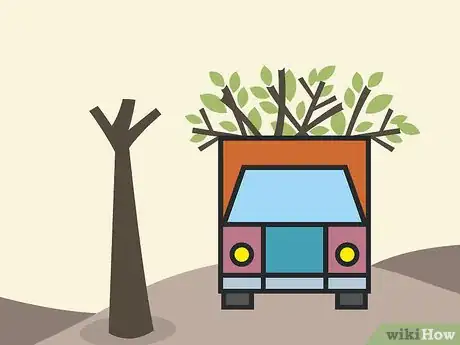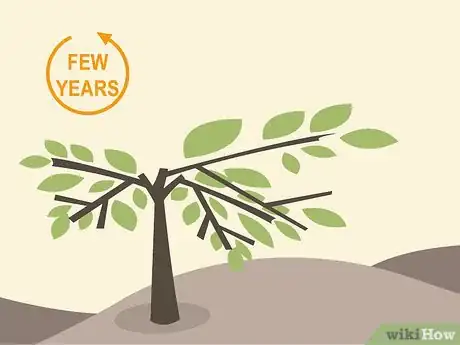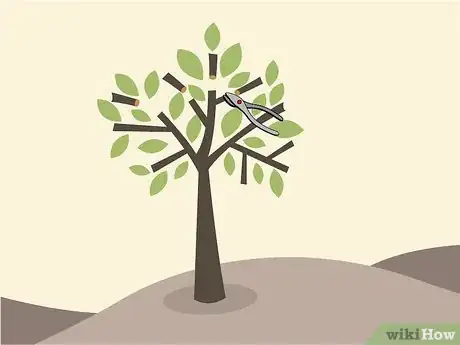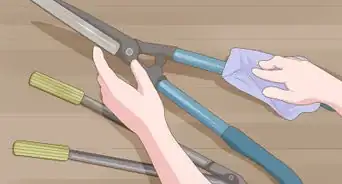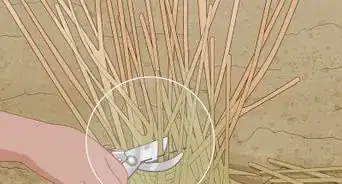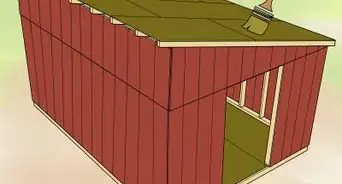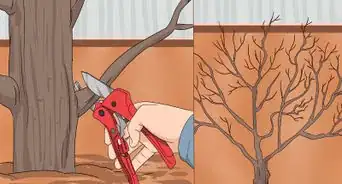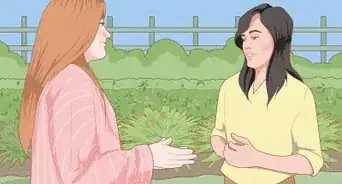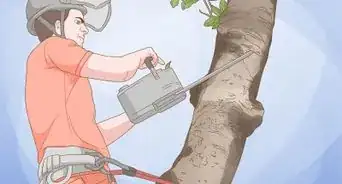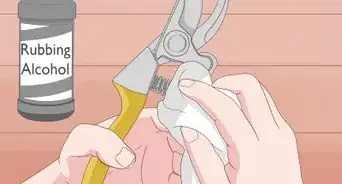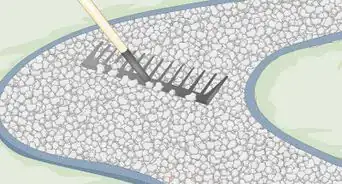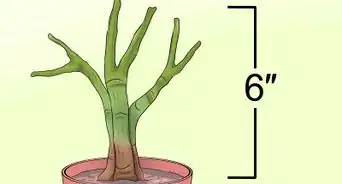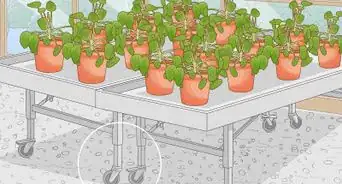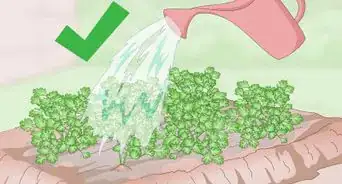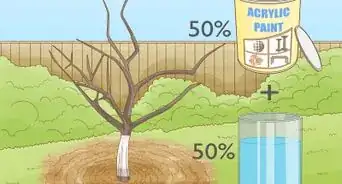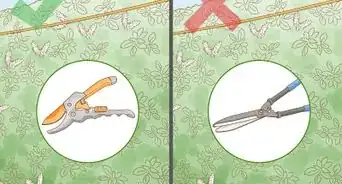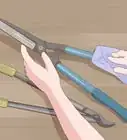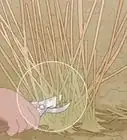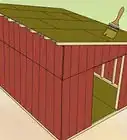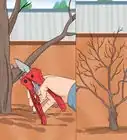This article was co-authored by Maggie Moran. Maggie Moran is a Professional Gardener in Pennsylvania.
There are 7 references cited in this article, which can be found at the bottom of the page.
This article has been viewed 43,296 times.
If a tree has grown so large that it no longer fits appropriately within its setting, some people advocate a solution known as tree topping. This involves the removal of all of the top branches of the tree, simply making it shorter. Tree topping is not generally recommended by tree-care professionals, as it can prove harmful to the health of a tree. Thinning is often a better option. However, in the case of a very large tree that's creating a problem, you may find that topping it with a chainsaw is your best course of action.
Steps
Making a Humboldt Cut
-
1Put on safety gear. Wear a long-sleeve shirt when operating a chainsaw. You should also wear safety gloves, safety goggles, ear protection, a hard-hat helmet, and chainsaw chaps. Each of these items is important: they protect you from injury while operating a chainsaw.[1]
- Chainsaw chaps are heavy aprons or pants made of layers of protective fabric, to be used when operating a chainsaw. You can purchase chaps online or at a hardware store.
-
2Clear the surrounding area. Make sure there is nothing in the area where the top of the tree is going to fall. Clear away any items such as dog houses, bird houses, fences or children's play equipment near the area where the branches will fall. If you are cutting down a whole tree, make sure you have a clear escape route so you can move safely out of the way as the tree topples.[2]
- Not all trees can be topped without professional help. If there are immovable objects in harm's way, (large structures, for instance, or power lines), consult a tree-care professional.
Advertisement -
3Start your chainsaw. Make sure you're standing comfortably. [3] Lay the chainsaw on a flat surface (such as the ground). Place your left hand on the handlebar and your right hand on the starter-rope handle. Pull the starter rope gently until you feel resistance. Then pull the rope toward you several times until the engine starts. (Consult the manufacturer's instructions for advice on using the choke mechanism.) Once the engine is running, briefly pull the throttle trigger to rev the engine (to make sure it will successfully accelerate). Then carefully lift up the chainsaw.[4]
- Make sure you have secure footing when starting a chainsaw. If you need to use something like a ladder to top a tree, it's not recommended you do so alone unless you have extensive experience operating a chainsaw. Stick to topping shorter trees where the branches can be reached when standing on the ground.
-
4Start with a horizontal cut. A Humboldt cut is a three-step process for cutting down a tree (or part of a tree). First cut into the trunk just above the highest branch you want to retain. Place the chainsaw against the side of the tree toward which you want the top to fall. Make a horizontal cut into the tree. Stop cutting when you're about 1/4 to 1/3 of the way through the tree's diameter. (In other words, stop cutting well before the chain reaches the center of the trunk.)[5]
-
5Add a second cut below the first one. After making your first cut, move your chainsaw down several inches. Angle the chainsaw upward and make a diagonal cut that connects with your first cut (again stopping about 1/3 of the way through the trunk). You're cutting a small, horizontal wedge out of the trunk. [6]
- A small chunk of the tree will fall to the ground after you make this second cut, leaving a gash in the tree's side. [7]
Removing the Top of the Tree
-
1Cut into the tree behind your Humboldt cut. The final step is to place the chainsaw on the other side of the tree (the side opposite the wedge you cut). Make a third cut about an inch below the first horizontal cut you made on the opposite side of the tree. [8]
-
2Allow the top to fall to the ground. Keep cutting into the tree until it topples toward the wedge cut. You may have to use your hands to push the tree top in the direction you want it to fall. NOTE: Do not even attempt this operation if the wind is blowing from the direction in which you want the top to fall. If you have a favorable wind/breeze, you may not have to push on the tree top at all. (It would be much better to top a tree on a day with no wind at all.) [9]
- Make sure the area where the tree will fall is clear and that people and animals are not nearby.
-
3Dispose of the tree top according to local regulations. Once the tree top is on the ground, disposal methods will vary by locale. You may have to transport the tree top to your city's dump. In some localities you may be able simply to move the tree top to a nearby wooded area.
Finding Alternatives
-
1Consult a professional. Topping is an aggressive -- even dangerous -- operation. It's not a good idea to top a large tree without professional consultation. Talk to an experienced logger or tree-care specialist before you decide to top a tall tree. There may be other options that will be better for the health of you and the tree.EXPERT TIPMaggie Moran is a Professional Gardener in Pennsylvania.Home & Garden Specialist

 Maggie Moran
Maggie Moran
Home & Garden SpecialistBe prepared to pay more for topping a larger tree. According to horticulturalist Maggie Moran, “The cost of professional topping depends on the size and height of the tree. The cost to handle a 30–60 feet (9.1–18.3 m) tree is between $150-$875 depending on the work involved.”
-
2Use topping only as a last resort. Topping is not typically recommended. New limbs that grow after topping can be abnormally weak. Topping can even reduce a tree's lifespan drastically. Besides, topping may prove ineffective: you'll be quickly rid of unwanted branches, but new (and less attractive) branches may soon grow back. [10]
-
3Try thinning instead. Thinning is a less dramatic method that can remove obstructive branches from a tree without harming it as much as topping would. In thinning you remove unwanted, individual branches of the tree at the trunk. You can take out branches that are causing problems without completely chopping off the tree's top.
Expert Q&A
Did you know you can get expert answers for this article?
Unlock expert answers by supporting wikiHow
-
QuestionHow much does it cost to top a tree?
 Maggie MoranMaggie Moran is a Professional Gardener in Pennsylvania.
Maggie MoranMaggie Moran is a Professional Gardener in Pennsylvania.
Home & Garden Specialist
-
QuestionWhat does "lop a tree" mean?
 Maggie MoranMaggie Moran is a Professional Gardener in Pennsylvania.
Maggie MoranMaggie Moran is a Professional Gardener in Pennsylvania.
Home & Garden Specialist
-
QuestionCan you top a pine tree?
 Maggie MoranMaggie Moran is a Professional Gardener in Pennsylvania.
Maggie MoranMaggie Moran is a Professional Gardener in Pennsylvania.
Home & Garden Specialist
Warnings
- Never let anyone walk around on the ground below you while you're starting or using a chainsaw or dropping branches. Keep children completely away from the area.⧼thumbs_response⧽
- Pick a non-windy day to top a tree. It's hard enough to make trees do what you want them to without fighting the wind at the same time. It's OK if there's a slight breeze, especially if it's blowing in the direction you want the tree top to fall.⧼thumbs_response⧽
- It can be dangerous to pull-start a chainsaw while you're up in a tree or at the top of a tall ladder. Situate yourself in a very stable and secure spot before firing up the saw. It's better if you can start the saw while you're on the ground and then carry it up, but that can be dangerous, too. A safer alternative, of course, is to use a hand saw or a logging saw.⧼thumbs_response⧽
References
- ↑ https://www.bobvila.com/articles/how-to-use-a-chainsaw/
- ↑ http://www.artofmanliness.com/2014/05/28/chainsaws-101-how-to-use-a-chainsaw-safely/
- ↑ https://www.bobvila.com/articles/how-to-use-a-chainsaw/
- ↑ http://www.stihl.com/step-by-step-starting.aspx
- ↑ https://www.osha.gov/SLTC/etools/logging/manual/felling/cuts/humbolt_top_cuts.html
- ↑ https://www.osha.gov/SLTC/etools/logging/manual/felling/cuts/humbolt_top_cuts.html
- ↑ https://www.youtube.com/watch?v=faXUU74Kprk&feature=youtu.be&t=105
- ↑ https://www.youtube.com/watch?v=faXUU74Kprk&feature=youtu.be&t=133
- ↑ https://www.youtube.com/watch?v=faXUU74Kprk&feature=youtu.be&t=133
